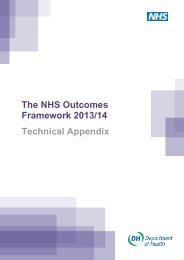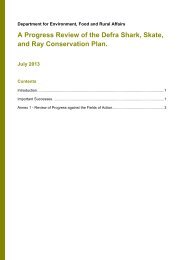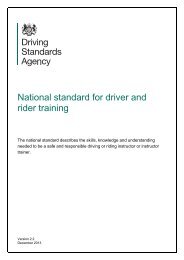Decontamination in primary care dental practices - Gov.uk
Decontamination in primary care dental practices - Gov.uk
Decontamination in primary care dental practices - Gov.uk
You also want an ePaper? Increase the reach of your titles
YUMPU automatically turns print PDFs into web optimized ePapers that Google loves.
19 Hot and cold water systems and <strong>dental</strong> unit water l<strong>in</strong>esTable 1 Tests for temperature performanceFrequency Check Cold water Hot water NotesMonthly † Sent<strong>in</strong>el outlets The water temperatureshould equilibrate below20oC after draw-off for2 m<strong>in</strong>utes 1,2 The water temperatureshould equilibrate to atleast 50oC after draw-offfor 1 m<strong>in</strong>ute 3These measurements areapplicable to non-mixedoutlets onlyMonthly Inlets to sent<strong>in</strong>el TMVs Temperatures as above Temperatures as above Measurements can bemade by means of surfacetemperature probesMonthly Water leav<strong>in</strong>g andreturn<strong>in</strong>g to calorifierAlso to be monitoredcont<strong>in</strong>uously by BMS6-monthlyIn-com<strong>in</strong>g cold water at<strong>in</strong>let to build<strong>in</strong>g – <strong>in</strong> thew<strong>in</strong>ter and <strong>in</strong> the summerThe water should bebelow 20°C 2The water temperatureAnnually ‡ Representative outlets The water temperature2 m<strong>in</strong>utes 1,2 for 1 m<strong>in</strong>ute 3should equilibrate below20oC after draw-off forshould equilibrate to atleast 50oC after draw-offNotes:Also to be cont<strong>in</strong>uouslymonitored by BMS† Sent<strong>in</strong>el outlets are normally those that – on a hot water service – are the first and last outlets on a recirculat<strong>in</strong>g system. Oncold water systems (or non-recirculat<strong>in</strong>g hot water systems), they are the closest and furthermost from the storage tank (orwater heater). The choice of sent<strong>in</strong>el taps should also <strong>in</strong>clude other outlets that are considered to represent a particular risk, forexample those <strong>in</strong>stalled <strong>in</strong> accommodation <strong>in</strong> which particularly susceptible patients are treated, or others identified <strong>in</strong> the riskassessment and temperature mapp<strong>in</strong>g exercise as hav<strong>in</strong>g the least satisfactory temperature performance.‡ Representative outlets <strong>in</strong>clude conventional and mixed-temperature taps; 20% of the total number <strong>in</strong>stalled throughout thepremises would be tested annually on a rotational basis: that is, all taps checked every five years.1. The Health & Safety Commission’s (2000) Approved Code of Practice L8 permits a period of two m<strong>in</strong>utes to achievean equilibrium temperature below 20°C. Achiev<strong>in</strong>g this m<strong>in</strong>imum requirement would be <strong>in</strong>dicative of an exceptionallyunderutilised water system. (At a typical flow to a wash-hand bas<strong>in</strong> of 4.5 L/m, 2 m<strong>in</strong>utes to achieve temperature would<strong>in</strong>dicate a 50 m dead-leg of 15 mm pipe.)2. The Water Supply (Water Quality) Regulations 2000 permit water undertakers to supply water to premises at temperaturesup to 25oC. In practice, the water temperature is likely to be below this maximum value, typically below 10oC <strong>in</strong> w<strong>in</strong>ter and20oC <strong>in</strong> summer. If, dur<strong>in</strong>g prolonged periods of high environmental temperature, the water temperature starts to exceed20oC, the water undertaker should be asked to see whether remedial action could be undertaken. With<strong>in</strong> the curtilage of thepremises, the aim should be to ensure that the temperature difference between the <strong>in</strong>-com<strong>in</strong>g supply and most distal parts ofthe distribution system is below 2oC.3. The Health & Safety Commission’s (2000) Approved Code of Practice L8 permits a period of 1 m<strong>in</strong>ute to achieve anequilibrium temperature of 50oC. A m<strong>in</strong>imum of 55oC may be required for the operation of suitable mix<strong>in</strong>g devices requiredto provide “safe” hot water at the upper limit of the recommended range. Hot water at 55oC is required <strong>in</strong> many cases forreasons of food hygiene or decontam<strong>in</strong>ation requirements, for example <strong>in</strong> kitchens and sluice rooms etc. In a properly balancedhot water circulat<strong>in</strong>g system, with the circulation taken close to the draw-off po<strong>in</strong>t, achiev<strong>in</strong>g temperature should be virtually<strong>in</strong>stantaneous. (At a typical flow to a wash-hand bas<strong>in</strong> of 4.5 L/m, 1 m<strong>in</strong>ute to achieve temperature would <strong>in</strong>dicate a 25 mdead-leg of 15 mm pipe.)73
















